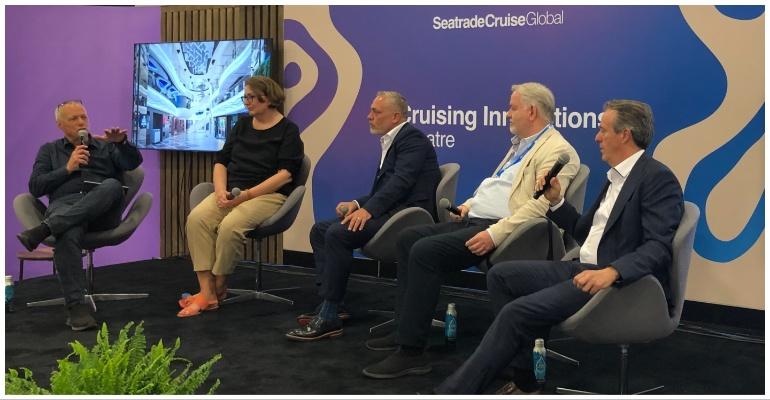That was one of the topics tackled at the “Cruise Design Spotlight” panel discussion at Seatrade Cruise Global on Wednesday.
Cabin wiring
“The challenge is, we all have our crystal balls,” said Trevor Young, VP newbuild at MSC Cruises, “but they’re quite foggy at times.” Young said one example of how to deal with the challenge comes in cabin design, where it is highly likely new control systems will be developed in coming decades.
“What you can do is wire the cabin so that you can add on these new things when they come on in time,” Young said.
Build in flexibility
“Thirty-five years is a long time,” added Iina Forsblom, partner and cruise design director at Tillberg Design of Sweden. “There are so many life cycles to that ship. What are the chances that it will be sailing for the same client or in the same region all of those years?”
Panelists agreed that a certain level of flexibility has to be built into good designs, and that lines can switch up some of the details in five-, 10- or 15- year refurbishments as long as the basic elements of the design are well conceived.
Listen to guests or shipowners?
Another dilemma is how much attention designers should pay either to the ideas of shipowner or the desires of cruise guests.
Feedback from guests that they felt disconnected from the water on bigger ships was influential in the design of Icon of the Seas, said Sascha Lang, VP architectural & design at Royal Caribbean Group.
Lang said he thought Royal did a “fantastic” job of incorporating that feedback into Icon’s design. “On both sides, you enter the ship at the boarding gate you just see ocean,” he said. “You see air, light and water.”
The perspective of owners can bring challenges, but also rewards, said Young, because sometimes guests don’t know what they want until they see it and owners can provide that. “We listen to our customers but we also like to give them something unexpected, as well. It’s unexpected, but its calculated,” Young said.
Refurbishments an 'important design laboratory'
During the pandemic, most cruise lines stopped refurbishing older ships, some of which exited their fleets. That removed an important design laboratory, Lang said. “For the existing fleet, the revive program was a tremendous tool to test, to listen to the customers, to upgrade the ship to the latest and greatest and then that eventually flowed from there into the newbuilds.”
New designs could be tried and launched much faster than on newbuilds, which can take five years to complete, he said. “I think all shipowners are very eager to open the revive program again.”
Copyright © 2024. All rights reserved. Seatrade, a trading name of Informa Markets (UK) Limited.
Add Seatrade Cruise News to your Google News feed.  |

